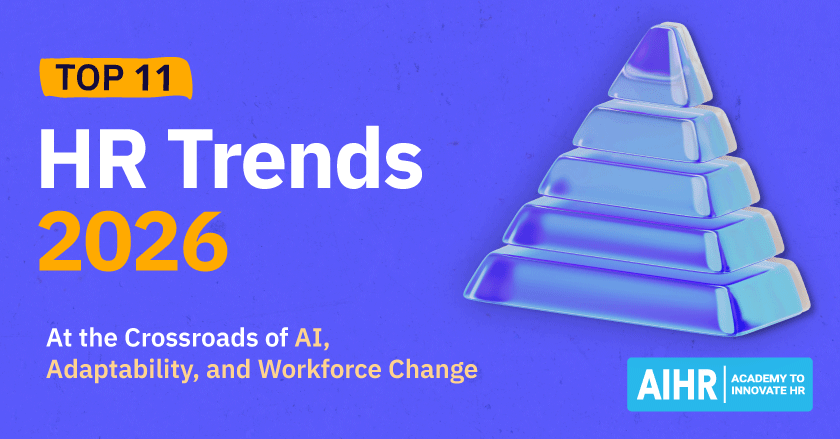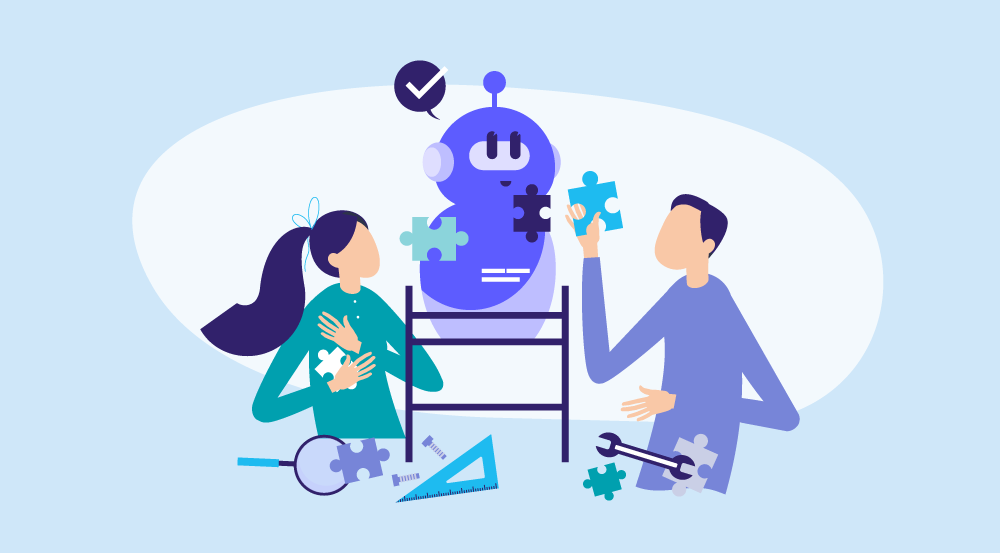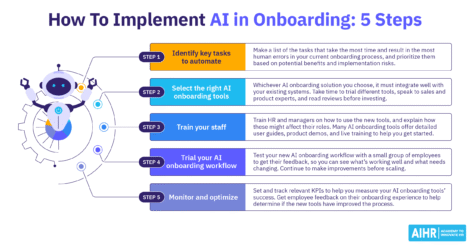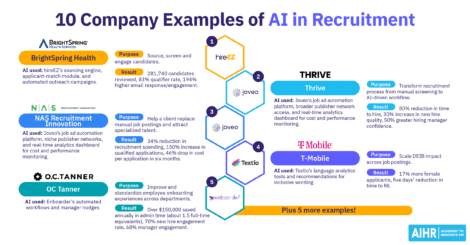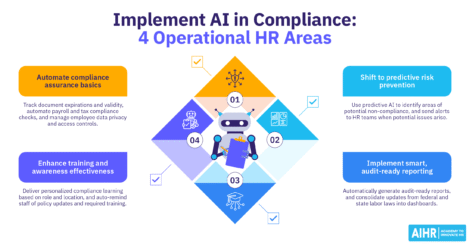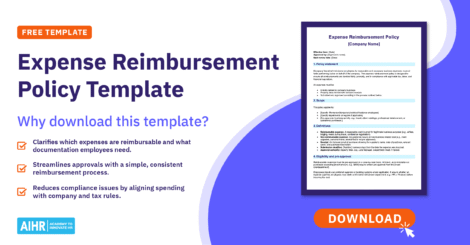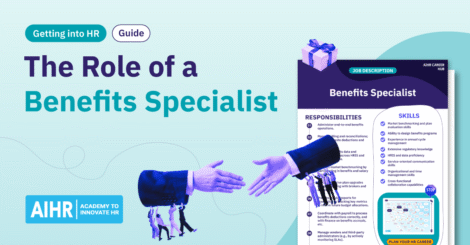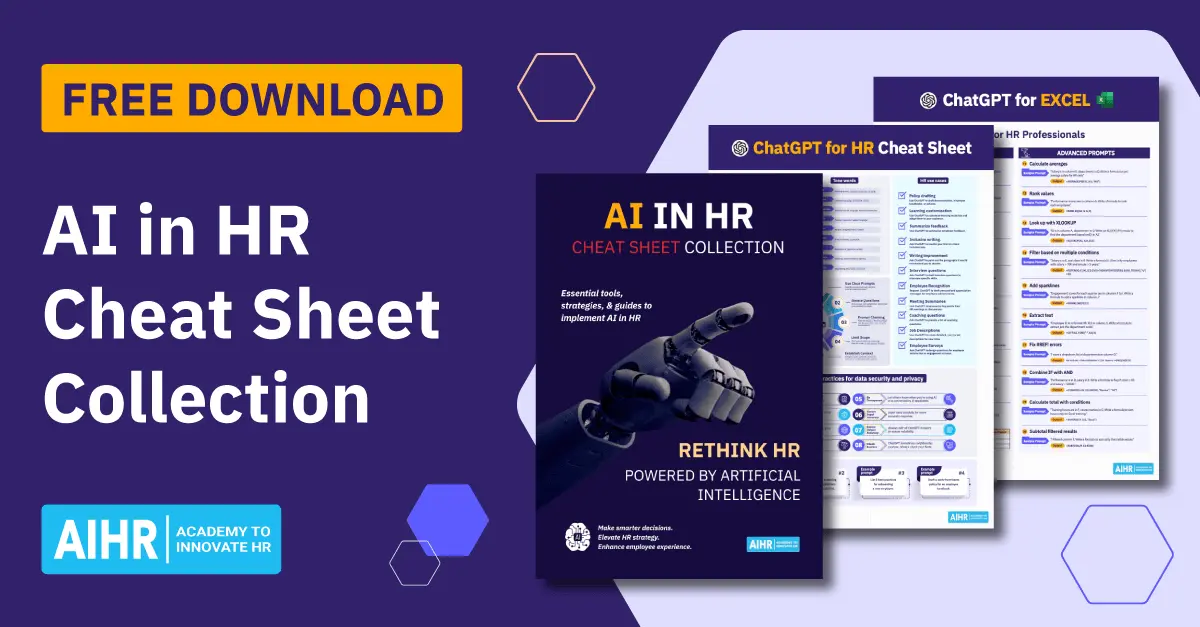AI for employee experience (EX) can support personalized work journeys, improving engagement and overall EX. Additionally, AI-driven machine learning can predict turnover with over 80% accuracy, allowing for pre-emptive intervention. Through automation and real-time data, AI is transforming HR processes and increasing employee productivity.
This article explores AI’s impact in the workplace, how HR can harness it to improve the employee experience, the pros and cons of doing so, and how to adhere to ethical standards throughout the process.
Contents
What is AI for employee experience?
AI for employee experience: Pros and cons
AI for employee experience examples
6 ways to improve employee experience using AI
How to measure employee experience using AI
10 steps to implement AI for employee experience
AIHR resources for HR professionals embracing AI
Key takeaways
- AI automates transactional support and tailors high-value processes, saving HR and managers time and creating more meaningful EX.
- AI targets administrative bottlenecks to deliver instantaneous, self-service support, creating seamless processes for greater employee satisfaction.
- To maintain trust, it’s essential to mitigate privacy breaches and data bias risks, prioritize transparency, and ensure protocols that involve humans on high-stakes issues.
- It’s important to start with small, manageable pilots, then gradually use more advanced tools to link EX signals directly to business outcomes.
What is AI for employee experience?
AI for employee experience uses your employee data (feedback, interactions, performance) to automate tasks and deliver personalized support, communication, and learning. This helps reduce friction among employees, managers, and company processes.
AI models streamline HR processes so employees get timely, relevant, and accurate help across the EX journey. Some example applications include:
- Employee onboarding: Auto-create role-based checklists.
- Support: Route IT/HR tickets and answer FAQ.
- Learning: Tailor course catalogs to role, goals, and feedback.
- Wellbeing: Flag high workloads and surface EAP resources.
- Performance and comms: Draft summaries, optimize meetings, and segment announcements by audience and tone.
AI’s impact on EX includes faster answers, fewer manual steps, targeted learning, early risk detection, and consistent service using bots or smart ticket routing. At the same time, its automation capabilities allow HR more time to focus on complex cases, strategy, and coaching.
AI for employee experience: Pros and cons
If you’re currently evaluating the use of AI for employee experience, it’s important to take a balanced view of both the efficiency gains and critical risks. These include:
Pros
- Time savings through automation and self-service: Chatbots and robotic process automation (RPA) can handle routine questions (“What’s the holiday policy?”), cutting admin time and improving response speed for employees and HR.
- Personalization at scale for training, comms and benefits: AI can match content to individual needs (e.g., training modules, benefits info, or messages) based on role and performance, making interactions more relevant.
- Always-on support: Chatbots and virtual assistants are able to provide 24/7 help across multiple time zones, eliminating frustrating wait times for urgent policy or IT questions, and reducing friction as a result.
- Better, data-driven decisions: You can use AI to analyze open-text feedback to help you identify patterns and sentiment, providing HR with predictive insights on risks like attrition and cultural issues.
Cons
- Data privacy concerns, bias, and hallucinations: More data means greater privacy risk. Models can inherit bias and generative tools can produce confident but wrong answers. As such, you need strong controls and monitoring.
- Change resistance and transparency gaps: Employees may resist AI adoption, fearing job displacement or intrusive monitoring. Unclear AI purpose can put a dent in employee trust and negatively affect EX.
- Integration and maintenance: Connecting AI to legacy HRIS/LMS is complex and costly. Maintaining non-native AI systems also requires constant maintenance to prevent ‘model drift’ (i.e., AI output accuracy degrades as organizational context changes.
- Over-automation: Over-reliance on AI for sensitive interactions (e.g., performance appraisal or wellbeing discussions) risks dehumanizing the workplace. To avoid this, keep the “human in the loop” for high-stakes decisions.
AI for employee experience examples
Not sure where to start when it comes to planning high-quality AI-powered employee journeys? Here’s a list of employee experience examples that showcase specific AI use cases:
- Onboarding copilot: Streamline the ramp-up for new recruits by auto-creating personalized day one agendas, include new hires in a buddy system at work, and flag IT for system access based on specific job roles.
- Policy Q&A chatbot: Implement a highly accurate knowledge bot that answers complex questions 24/7, and escalates only complex cases to human specialists. This can significantly reduce HR help desk volume.
- Skills-based learning paths: Use AI for employee skills assessment, as well as to analyze career goals, and company needs to build custom learning journeys. These tools can help ensure AI-driven employee training is targeted, relevant, and efficient.
- Career pathing reminders for internal mobility: Proactively suggest relevant internal roles aligned with an employee’s skills, and use AI to send reminders about the training needed to close the skill gaps for their next promotion.
- Performance prep assistant: Before a review, AI can draft a summary for managers and employees. This can strengthen quantitative goals, project notes, and 360 degree feedback, while saving time and reducing the administrative burden for both parties.
- Manager 1:1 assistant: Compile essential talking points for weekly check-ins by pulling data on workloads, progress on goals, and aggregated team sentiment to help focus conversations on support and development.
- Wellbeing triage system: Use indicators from scheduling and login patterns to identify potential burnout risks among your company’s workforce. This AI can then gather curated EAP resources or deliver timely micro-break prompts.
- Scheduling optimizer (shift work): For large teams, AI can create fair, balanced shift patterns that account for regulatory requirements and employee preferences. This also reduces the time management would otherwise spend on manual adjustments.
- Internal comms generator: Your internal comms team can use AI to draft targeted, plain-language messaging for specific employee groups. They can also use it to test different tones of voice to accurately predict engagement.
- Recognition recommender: Employee recognition is critical for positive EX. AI tools can monitor team activity, proactively prompt managers to recognize specific wins, and suggest personalized wording for recognition messages.
- Ticket routing and prioritization: AI machine learning algorithms can predict the urgency and required expertise for IT and HR tickets, allowing them to be instantly assigned to the right owner with the correct priority ranking.
- Facilities and IT insights: AI can analyze open text and ticket categories over time to detect patterns (e.g., recurring printer or air-conditioning issues) and suggest systemic fixes that can lead to better EX.
HR tip
Successful application of AI for employee experience requires HR professionals to master three critical skills: prompt engineering (to optimize workflows), using generative AI in HR (hands-on platform skills), and AI strategy for HR (plan for AI readiness). AIHR’s AI for HR Certificate Program teaches these competencies to help you develop future-ready HR skills.
6 ways to improve employee experience using AI
If you’re wondering how to improve employee experience at your company, here are six ways to do so by using AI in employee onboarding, staff training, and HR process optimization:
1. Automate the basics to eliminate friction
Set up AI-powered chatbots to instantly handle high-volume, low-complexity requests, such as frequently asked questions, policy lookup, and automatically routing complex IT/HR tickets to the correct human team. This way, staff can avoid complex system navigation and HR can minimize time-consuming tasks.
2. Personalize learning and development
AI tools can analyze roles, identify skills gaps, align individual goals with company needs, and customize learning journeys. They can also recommend targeted micro-courses, ensuring that all AI for employee training is relevant, efficient, and directly contributes to meaningful career growth and job satisfaction.
3. Segment target audiences
Use generative AI to draft and tailor internal announcements to suit different audience segments. You can also use it to generate communications based on real-time data (e.g., location, role, shift) so employees only receive relevant information. This can also reduce overall email fatigue.
Learn to use AI for employee experience
To use AI ethically and efficiently to boost EX, you must start small, set clear metrics, secure data, keep humans in the loop, audit regularly, and train managers.
✅ Understand the different types of AI, including purposes and benefits
✅ Apply an AI adoption framework to transform workflows and processes
✅ Apply advanced prompting techniques and adapt to your role
✅ Learn best practices for using Gen AI safely, securely, and ethically
Learn at your own pace with the online Artificial Intelligence for HR Certificate Program.
4. Make managers copilots in people leadership
Equip line managers with AI-powered ‘copilot’ tools to enable them to identify and address potential issues early, and prep tailored one-on-one agendas. This helps them identify and address potential issues early and transform themselves from administrators to effective coaches.
5. Curate moments that matter
AI can help HR teams deliver timely, personalized experiences during key employee milestones, such as onboarding, promotions, relocations, or returns from leave.
For example, AI can trigger tailored new hire checklists based on role and location, recommend relevant learning content during a role transition, or send nudges for managers to check in after a major life event. Automating and customizing these moments helps ensure every employee feels seen, supported, and set up for success.
6. Enhance accessibility and inclusion
AI tools can improve accessibility by providing live transcription in virtual meetings and town halls, and simplifying internal documentation to ensure clear comprehension across a diverse workforce. This makes your AI for EX efforts inclusive and is likely to improve engagement, motivation, and the employee retention rate.
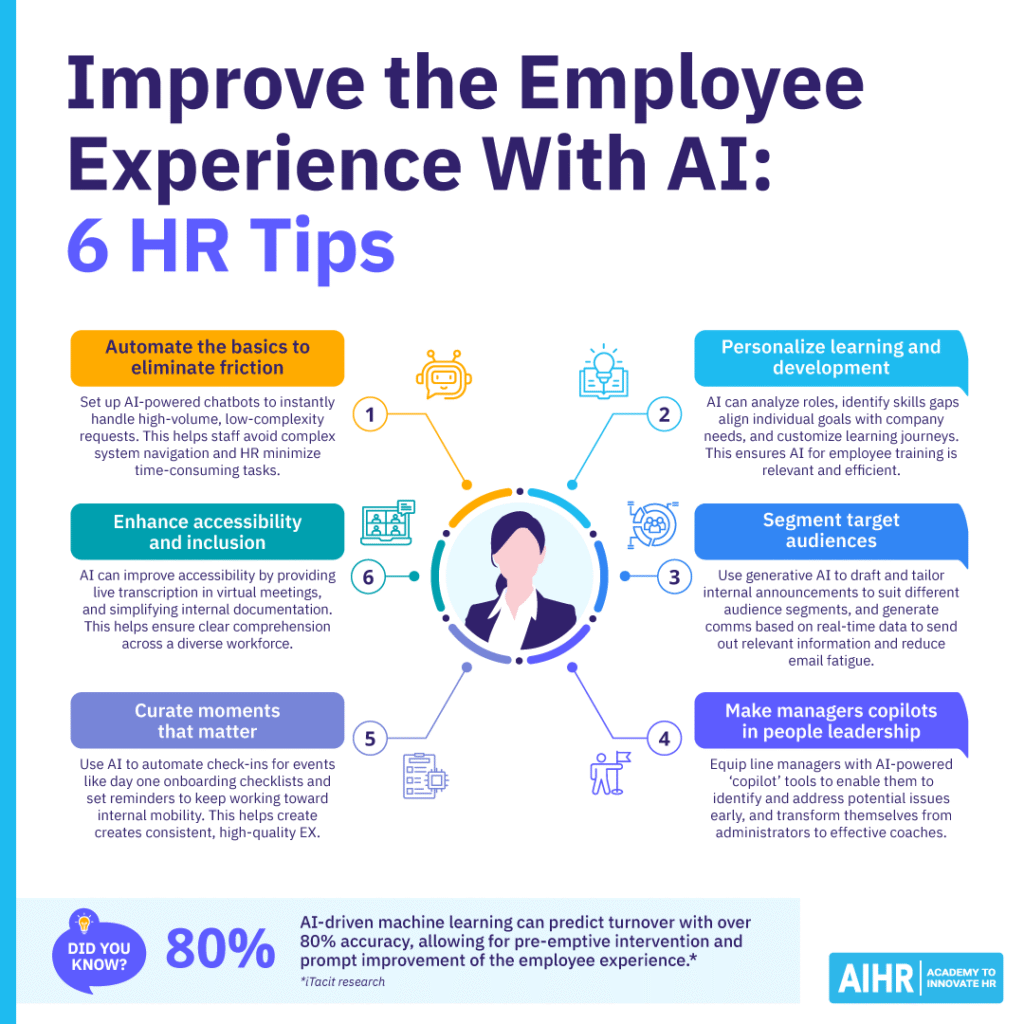
How to measure employee experience using AI
HR professionals must be able to accurately measure employee experience to justify their investment in new initiatives. AI transforms EX measurement from sporadic survey collection into continuous, real-time diagnostics, helping you build accurate, predictive models. Here are some AI-driven methods you can use to measure EX:
Always-on listening and theme detection
AI can handle exceedingly high volumes of open-text data from continuous feedback channels, such as employee feedback surveys and forums. It can then automatically summarize vast amounts of unstructured feedback and flag statistically significant emerging themes (e.g., ‘lack of policy clarity’) that human analysts might miss.
Deep sentiment analysis
AI tools use natural language processing (NLP) to perform employee sentiment analysis. Simply put, this means tracking your workforce’s emotional tone (positive, negative, or neutral) by team or region over time. This helps HR gauge morale in quantifiable terms and allows you to help managers address low engagement risk areas before they spread or impact turnover.
Integrated journey analytics
Instead of relying solely on self-reported data, AI tracks objective metrics across systems to understand the employee life cycle. Key analytics typically include time to resolve HR tickets, first-contact resolution rates, and learning adoption rates. These operational metrics specifically highlight the systemic friction points that need attention.
Outcome links and predictive modeling
AI’s greatest value in terms of HR measurement lies in its ability to correlate EX signals with hard business outcomes. You can train your AI models to identify negative sentiment patterns and link them to increases in employee attrition or absenteeism, or decreases in customer satisfaction. This provides the crucial data you need to support targeted EX investments.
Actionable dashboards
AI-powered systems can automatically translate complex data into digestible summary views for executives and managers. These HR dashboards are designed to feature data drill-downs and provide context-specific, recommended actions for line managers (e.g., ‘Schedule a 1:1 with Maria due to high burnout risk signal’).
10 steps to implement AI for employee experience
When it comes to successful AI integration, change management and governance are just as important as the technology itself. Here’s a 10-step process using an AI benefits chatbot scenario that explains how to roll out AI to improve the employee experience:
Step 1: Pick one high-friction point for proof of concept
Start small so you don’t become overwhelmed. Choose one busy area — such as questions about compensation and benefits — and focus solely on that area. Next, list the most common questions, take note of what you will not cover, and record current response times so you can make comparisons later on.
Step 2: Define quantifiable success metrics
Agree on a few numbers that define success. This may include faster answers, more questions solved on the first try, fewer tickets, and high satisfaction scores. Set exact goals (for instance, 50% faster replies) and decide what happens if you manage to hit them several weeks in a row.
Step 3: Map all relevant data and system dependencies
Gather the official sources for your answers (e.g., HRIS, SharePoint, or benefits sites). Label what’s sensitive, decide who can access what, and make sure the bot always points to a specific source. Be sure to also keep the content updated to avoid stale or duplicate answers.
Step 4: Select a pilot tool for low-risk, high-volume workflow
Shortlist a few vendors that offer strong security and easy integrations, then test them using real employee questions. When you’re done, compare accuracy, speed, and source citation, and choose the one that works best with your existing HR tools and systems.
Step 5: Establish governance and privacy protocols
Only collect what you need, set retention limits, and control who can make changes to the content. At the same time, switch on audit logs and state the bot’s limits clearly in the interface. You should also define how the system escalates sensitive topics to human employees.
Step 6: Build prompts, guardrails, and escalation rules
Instruct the bot to use plain language, cite its sources, and say, “I don’t know” when it’s unsure. Additionally, remember to create simple rules: for example, certain keywords or low confidence could trigger a handoff to HR. At the same time, keep reusable prompts and reply templates.
Step 7: Train internal champions and stakeholders
Thoroughly train HR Business Partners (HRBPs), managers, and your help desk team on how the AI works, and make them aware of its limitations. Also provide them with a quick-start guide and one place to submit fixes or new questions; they can then help others use it and spot issues early.
Step 8: Launch to a small cohort and collect feedback weekly
During your pilot, roll out the AI solution to HR to test it first, then to one business unit (e.g., Finance or Marketing) at a time. Implement a mechanism to collect qualitative feedback that includes EX, and information accuracy ratings. Be sure to review this data on a weekly basis.
Step 9: Measure, analyze, and iterate continuously
Compare data from your pilot against benchmark metrics to assess AI response accuracy ratings and employee satisfaction levels. If accuracy is low on a particular topic (e.g., 401k withdrawals), retrain your model immediately with more accurate source data.
Step 10: Scale to adjacent use cases and update policies
Once your benefits chatbot is stable, scale your knowledge base to handle additional areas, such as onboarding FAQs and personalized employee training. As your AI chatbot evolves, update your HR technology policies to reflect the wider use of GenAI in your organization.
AIHR resources for HR professionals embracing AI
Interested in learning more about how AI is reshaping HR today? The Artificial Intelligence for HR Certificate Program will equip you with the knowledge you need to implement and govern responsible AI-enabled HR solutions.
Through this program, you can also earn Professional Development Credits (PDCs) to maintain your accreditation with prestigious associations such as SHRM and HRCI. Completing this program will enable you to lead digital transformations that enhance efficiency, improve employee experience, and positively impact your company’s growth.
You can also learn more about AI’s HR use cases on AIHR’s blog, through the following articles:
- AI in HR: A Comprehensive Guide
- 9 Key Benefits of AI in HR: How You Can Use AI in Your Role
- AI for Performance Reviews: Tools & Strategies for Smarter Talent Decisions
Next steps
Don’t feel like you need to master everything at once. Start by picking one task you handle often, like answering policy questions or drafting comms, and try solving it with an AI tool you’re comfortable with. Keep it simple and see what kind of time or effort it saves you.
Once you feel more confident, try applying it to something a little bigger, like analyzing survey feedback or creating learning plans. Set a personal goal, such as cutting down admin time by X% or improving how you personalize support for your team.
As you explore more use cases, keep a few basics in mind: protect sensitive data, sense-check the results, and use your judgment for anything people-related. AI is here to help, not replace your voice or your values.


